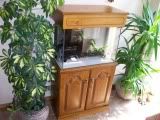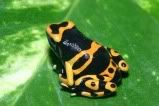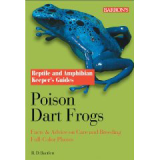Retirement and forum shutdown (17 Jan 2022)
Hi,
John Howell who has managed the forum for years is getting on and wishes to retire from the role of managing it.
Over the years, he has managed the forum through good days and bad days and he has always been fair.
He has managed to bring his passion for fish keeping to the forum and keep it going for so long.
I wish to thank John for his hard work in keeping the forum going.
With John wishing to "retire" from the role of managing the forum and the forum receiving very little traffic, I think we must agree that forum has come to a natural conclusion and it's time to put it to rest.
I am proposing that the forum be made read-only from March 2022 onwards and that no new users or content be created. The website is still registered for several more years, so the content will still be accessible but no new topics or replies will be allowed.
If there is interest from the ITFS or other fish keeping clubs, we may redirect traffic to them or to a Facebook group but will not actively manage it.
I'd like to thank everyone over the years who helped with forum, posted a reply, started a new topic, ask a question and helped a newbie in fish keeping. And thank you to the sponsors who helped us along the away. Hopefully it made the hobby stronger.
I'd especially like to thank John Howell and Valerie Rousseau for all of their contributions, without them the forum would have never been has successful.
Thank you
Darragh Sherwin
Under the Leaf Litter!
- Puddlefish (Colin McCourt)
-
 Topic Author
Topic Author
- Offline
- Senior Member
-

- Posts: 347
- Thank you received: 10
inc. Dendrobates & Killifish
by
Puddlefish
Introduction.
...Spawned from an idea I have been harbouring for quite some time now, I have decided I would like to try my hand at building and stocking a Paludarium, which would eventually become home to both Poisonous Dart-frogs (Dendrobatidae) & my beloved Killifish. Building a natural looking environment to accommodate both natural occurring land and aquatic species and all that entails would surely lead to a stunning visual display, once complete.
It is envisaged that I will use my original wood cabinet as a stand for the Paludarium and a new custom made glass tank would have to be constructed to remain within the constraints of its footprint. I'm planning on building a 625 x 312 x 610 (LWH) tank. complete with land and water segments.
I wish to keep this as natural as possible (modelled on a South American Rainforest biotope)
I hope to include some hard landscaping to include, tree roots, branches and exotic planting.
I will need to do a lot of research on this project surrounding the frogs themselves and also the flora, something that I'm sure I'll enjoy and probably to the complete annoyance of Ian on this forum.
Please follow as I proceed with this venture, join in with your comments and suggestions as I make this journey into the semi unknown.
Potential Paludarium...minus the new, taller tank
...After much consultation and dialogue with many frog enthusiasts, it seems that the most idiot proof PDF species (within reason) is the Yellow-banded Poison Frog ( Dendrobates leucomelas )...see pic below
Whilst not the most colourful species in the world but it has become apparent that they present less demands upon their owners and may be more suited to the environment I have in mind. Another worrying factor to all this is the fact that PDF's do not swim too well so provisions will have to be made on that score to minimise accidents. I haven't given this aspect much thought to date but it needs to be addressed as I intend to keep a few gallons of water within the eventual set-up.
...I have taken the liberty of ordering three small books pertaining to the topic in hand to educate myself a little further on Dartfrog husbandry. Whilst small in stature, I hope these little books will offer up the basic care strategies that need to be employed to look after these little amphibians sucessfully.
Poison Dart Frogs (Complete Herp Care Series) by Amanda Sihler
Natural Terrariums (Complete Herp Care Series) by Philip Purser
Retile Keeper's Guide: Poison Dart Frog (Reptile keeper's guides) by R.D. Bartlett
...I've managed to get the initial glass cut. Five pieces of 6mm plate were broke out to make a tank of the dimensions 625mm x 312mm x 610mm (pics to follow). I will drill all the drainage holes for the land mass and misting/fogging heads once I have decided on how I want the final layout to look.
The Equipment.
Substrates.
Landscape & Decor.
Balancing the System.
The Inhabitants.
As the Paludarium build progresses I suppose the eventual inhabitants should not be overlooked. Along with a group of Rivulus xiphidius in the stream section. I will be keeping a small group of Poisonous Dartfrogs (PDF's). The species of choice due to it's more forgiving nature and beginner friendly demeanour will be Dendrobates leucomelas or Banded Dart Frog. They need a fair amout of land mass for a group so I should only be able to keep three individuals (1male : 2females) at the most. There is a substantial amount of data available from various internet sources on this little beauty. Here follows a small, concise descriptive index on the species in question.
I)...Location & History:
II)...Description & Behaviour:
III)...Difficulty:
IV)...General Care:
V)...Breeding & Tadpole Care:
Foods and Feeding.
Resources.
*Please note, This is likely to be a lengthy process, it sure as hell aint gonna happen overnight, I will keep all the journal together in this top thread/post. (Space permitting) and will announce updates below as new and exciting developments are made.
I look forward to having you on-board for the ride.
Cue Ian....I'm depending on your help here buddy
Regards
BigC
Please Log in to join the conversation.
- Steveo (Stephen Forster)
- Offline
- Junior Member
-

- Posts: 31
- Thank you received: 0
Please Log in to join the conversation.
- Sofiztikated (Kenny Gibson)
- Offline
- Junior Member
-

- Posts: 61
- Thank you received: 0
Please Log in to join the conversation.
- wolfsburg (wolfsburg)
-

- Visitor
-

Please Log in to join the conversation.
- derek (Derek Doyle)
-

- Offline
- Platinum Member
-

- Posts: 1397
- Thank you received: 133
love the way you illustrate each article.
30 tanks specialise in african cichlids, angelfish and various catfish
Please Log in to join the conversation.
- mickdeja (Mick Whelan)
-

- Offline
- Platinum Member
-

- Posts: 1142
- Thank you received: 36
Follow me up to Carlow
Please Log in to join the conversation.
- platty252 (Darren Dalton)
-

- Offline
- Moderator
-

- Posts: 2309
- Thank you received: 127
Just a suggestion to stop the PDF's drowning, you could try dwarf lilly pads or large floating plants. I'm sure the killies would also appreciate them.
Please Log in to join the conversation.
- dar (darren curry)
-

- Offline
- Platinum Member
-

- Posts: 1539
- Thank you received: 17
Check out the angling section, it is fantastic
Please Log in to join the conversation.
- Puddlefish (Colin McCourt)
-
 Topic Author
Topic Author
- Offline
- Senior Member
-

- Posts: 347
- Thank you received: 10
From speaking with Ian and reading books on the topic, PDF's acquire their toxicity from the food they eat in their natural habitat. Since we cannot provide this aspect of their diet then the frogs are essentially detoxified.
Regards
C
Please Log in to join the conversation.
- platty252 (Darren Dalton)
-

- Offline
- Moderator
-

- Posts: 2309
- Thank you received: 127
I think the poison comes from a food source in the wild.
Someone with experience with these should be able to give better info.
EDIT: I'm just to slow at typing
Please Log in to join the conversation.
- dar (darren curry)
-

- Offline
- Platinum Member
-

- Posts: 1539
- Thank you received: 17
Check out the angling section, it is fantastic
Please Log in to join the conversation.
- Posts: 1420
- Thank you received: 2
yet another pushing the subscribe button. I have been interested in this idea since i visited the Berlin aquarium and zoo. I love birds, fish and reptiles but getting the space to have all well this is the way to go so i will be following your progress and will be asking to many questions
Mickey
Mickey Wallace & Cath Woods
Please Log in to join the conversation.
- Puddlefish (Colin McCourt)
-
 Topic Author
Topic Author
- Offline
- Senior Member
-

- Posts: 347
- Thank you received: 10
Regards
C
Please Log in to join the conversation.
- wolfsburg (wolfsburg)
-

- Visitor
-

I had a great chat with them in the shop a few weeks ago and got some very interesting advice as I have had an on-off relationship with D. auratus over the past 18 months or so! They're difficult buggers to keep alive!
You probably aren't going to be in that neck of the woods soon but if you need any advice Cees may reply to a PM.
Please Log in to join the conversation.
- igmillichip (ian millichip)
-

- Offline
- Moderator
-

- Posts: 3366
- Thank you received: 536
A few points I noted from replies:
Drowning.....I had been chatting to puddlefish on this and gave indicators on how to prevent drowning. Really, the PDFs should not have direct access to the bulk part of the aquarium water. they can drown within a centimeter of water.....and males will often kill other males by drowning them.
In effect, the PDFs would be in a different tank only separated by a mesh system or dividers.
There also needs to be consideration of what fish are used.....you couldn't house a brackish tank where the frogs would have direct access to any of the water as they would probably not tolerate the salt.
Chlorine.....fish will tolerate chlorine in the water better than frogs.
Toxins......captive bred will not have any toxins (well, not for nearly all PDFs.....but there are a few Mantellas who might be able to produce their own). Wild Caught will eventually lose their toxins, but it can be a slow process.
I would not, however, advise keeping wild caught PDFs as a starter....and certainly if D. tinc. azureus is wild caught or an offspring of wild-caught then it is illegally caught.
Not all PDFs actually have the lethal toxicity in the wild that legend would have many believe......
BUT, PDFs contain some of the most lethal toxins known to science.
Those PDFs that have lethal toxins of severe medical significance are truely dangerous. One of them is probably the most toxic substance that I can think of found in any animal.
Just my first jottings to comment on concerns shared by people.
Best of luck with the project.
ian
Irish Tropical Fish Society (ITFS) Member.
Please Log in to join the conversation.
- Johnl (John)
- Offline
- Junior Member
-

- Posts: 37
- Thank you received: 0
Please Log in to join the conversation.
- igmillichip (ian millichip)
-

- Offline
- Moderator
-

- Posts: 3366
- Thank you received: 536
For anyone who was at the IFTS show on Sunday, you could probably see some of the problems that I had consider when displaying mixed species in a relatively small tank (2foot by 1 by 1 foot) on a hot day:
a) potential aggression….but that was not a problem for a temp display as territories had not been set-out and I was on hand
b) Small vivariums cause problems in the difficulties of adding UV lamps…..I used soluble calcium and vitamin D3 supplements for temp housing in small vivs to get over this.
c) Overheating on a hot day……it was hot on Sunday, and getting very close to a dangerous level. I installed a fan system and had the external nebuliser ready.
d) Rapid cooling on a cold day (but not at the fish show  )
e) Stagnation……..you need to have a fan, but then that needs to be safely housed and also not allow the humidity to drop too low. Low humidity will kill very rapidly.
f) These guys are fantastic escape artists…..but death will be rapid if they did escape and I couldn’t find them.
For most part in PDF keeping, it is getting the viv right in the first place. There are many technical problems to overcome…..and you often find dilemmas such as ‘how do I have plenty of air movement yet keep humidity up high’?
The other dilemma is how to deliver the UVB and UVA light that dart frogs require to greater of lesser extents depending on species, age, mating etc without cooking the frogs?
A mercury vapour lamp will produce an incredible amount of heat, and would have to somewhere between 3 to 4 feet (minimum) above the highest place that the frogs may bask. That is a problem……..you can’t mount it inside a viv unless the viv is pretty massive; and then you need to stop the frog climbing near it. If you mount it outside the viv, then you’d need a mesh top…..but hey, that would compromise the humidity.
The mercury vapour UVB/UVA lamps are the ideal for PDFs….but with the mechanical problems involved, they are best not used (or maybe the occasional zap through a mesh top could be fine.)
So, that leaves us with 3rd best (the sun being 1st, mercury vapour 2nd)…UVB fluorescent tubes of low output (2% or 5%). These will be fine, and are cool in operation. The Compact UV lamps should not be used as many of the lamps manufactured pre-this year produced UVC (non-terrestrial UV), and most compacts have a poor UVA output.
Another alternative that works very well (but not ideal) is to use something like low concentration of Zolcal (a highly soluble calcium and vitamin D3 mix) in the water baths from time to time (but not at every change). Then calcium dusting or gut-loaded food is also required.
I’ve heard nonsense were people say PDFs don’t need UV light…..not true, but if UV light is not given, then something else needs to be given instead to get healthy frogs that may even breed to produce viable long-live (10, 15, 20 years) offspring without spindle leg.
In a good clean environment, PDFs will thrive with very little difficulties if their basic requirements are met.
There are a few species that I would not recommend people start with, but then those species are not likely to be readily available in Ireland anyway.
And…...a final word…....for now at least…..support captive bred specimens; don’t buy wild caught especially if that encourages illegal capture and export of certain species.
ian
Irish Tropical Fish Society (ITFS) Member.
Please Log in to join the conversation.
- Gavin (Gavin)
-

- Offline
- Premium Member
-

- Posts: 518
- Thank you received: 24
dont make me come over there.
Please Log in to join the conversation.
- igmillichip (ian millichip)
-

- Offline
- Moderator
-

- Posts: 3366
- Thank you received: 536
as far as i'm aware the current thinking on the poison comes from a small species of fire ant that they eat.they synthesize it buy an as yet unknown way. I think.

love pdf's was a nice set up at the show.
Hi Gav, it is more likely to be primarily from mites but ants could also be cited within.
The variety of alkaloid toxins is pretty large. In fact so large, that the different alkaloid toxins are classed into over 20 different chemical groups.
So, that may indicate that it is multiple sources exist for the toxins; and different species may have different dietary sources.
In some PDFs, however, the frog itself will take a relatively low toxicity compound and convert it into something of significant toxicity. Oophage pumilio is one such dart frog that can do that.
But here is a very sad fact.....many thousands of dart frog were killed in the search for how they made the toxins.....yet if someone had cottoned on the dietary source, then those frogs need not have been killed.
My primary qualification is as a medical toxicologist/pharmacologist...........so these things fascinate me.
I, however, refrain from spewing my dry thoughts of my academic passion on digital format (for now anyway)
ian
Irish Tropical Fish Society (ITFS) Member.
Please Log in to join the conversation.
- Johnl (John)
- Offline
- Junior Member
-

- Posts: 37
- Thank you received: 0
Please Log in to join the conversation.
- stretnik (stretnik)
-

- Visitor
-

Kev.
Please Log in to join the conversation.
- Viperbot (Jason Hughes)
-

- Offline
- Platinum Member
-

- Posts: 1597
- Thank you received: 42
Jay
Location: Finglas, North Dublin.
Life
may not be the party we hoped for, but while we
are here we might as well dance.
Please Log in to join the conversation.
- Johnl (John)
- Offline
- Junior Member
-

- Posts: 37
- Thank you received: 0
Please Log in to join the conversation.









